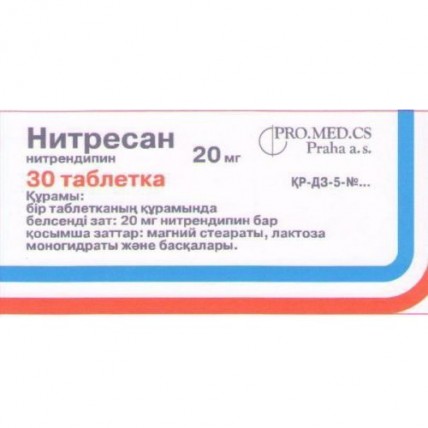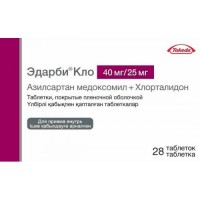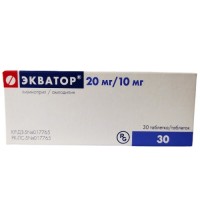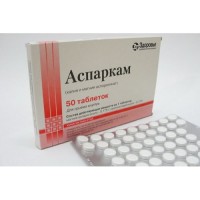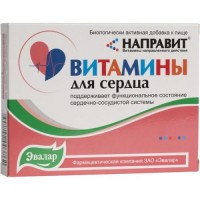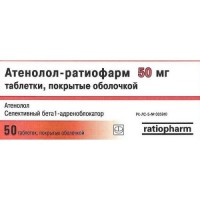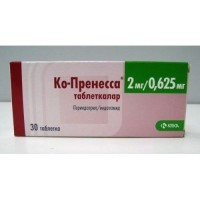Nitresan 20 mg (30 tablets)
- $25.20
The instruction for medical use
of Nitresan Torgovoye medicine a name
Nitresan
the International
name Nitrendipin Lekarstvennaya a form
of the Tablet of 10 mg, 20 mg
Structure
One tablet contains
active agent – nitrendipin 10 mg, 20 mg,
excipients: lactoses monohydrate, starch corn, cellulose microcrystalline, povidone 25, sodium docusate, magnesium stearate.
The description
of the Tablet of yellow color with a flat surface, with risky on one party and a dosage on other party, with a diameter about 7.0 mm (for dosages of 10 mg and 20 mg).
Pharmacotherapeutic group
Blockers of slow calcium channels selection.
Dihydropyridinic derivatives.
The code of automatic telephone exchange C08CA08
the Pharmacological
Pharmacokinetics At properties intake nitrendipin quickly and almost is completely soaked up, bioavailability – about 88%. The biological half-life of absorption makes 30 – 60 minutes. The peak of concentration in plasma is reached within 1 - 3 hours after administration of drug, average maximum concentration (Cmax) makes about 6.1 - 19 mkg/l. Considering considerable influence of the first passing through a liver (first-pass effect), system availability of a nitrendipin makes 20 – 30%.
96-98% of a nitrendipin contact proteins of blood plasma (albumine) and therefore are not exposed to dialysis. Nitrendipin cannot be eliminated with a hemodialysis or peritoneal dialysis. Distribution volume in steady state is about 5-9 l/kg of body weight.
At intake nitrendipin undergoes significant metabolic changes already at the first passing through a liver (first-pass effect), and it is almost completely metabolized as a result of oxidizing processes in a liver. Its metabolites of a pharmakodinamicheska are not effective. Less than 0.1% of an oral dose are removed in an invariable view with urine. Nitrendipin in the form of metabolites is generally allocated by means of kidneys (about 77% of an oral dose), the rest to be removed with bile and a chair.
The half-cycle of removal of the nitrendipin accepted in the form of tablets makes about 8-12 hours. Cumulation of active agent or its metabolites in an organism after achievement of steady state is not observed.
As nitrendipin it is removed generally in the form of metabolites, at patients with a chronic disease of a liver, its removal from an organism happens much more slowly: the biological half-life period is extended by 2-3 times. Special regulation of a dosage is not required from patients with renal failures.
The pharmacodynamics
Nitresan is a blocker of calcium channels of 1.4-dihydropyridinic type which works as antihypertensive drug.
Nitresan inhibits transmembrane passing of calcium ions to cells of smooth muscles of vessels. It leads to protection against excessive penetration of calcium into a cell, an ingibition calcium - dependent myogenetic reductions of smooth muscles of vessels, to decrease in vascular peripheric resistance, decrease patholologically in the increased arterial blood pressure of blood, to insignificant natriuretic effect, especially in an initiation of treatment.
Indications
- treatment of essential (primary) hypertensia
the Route of administration and doses
Treatment is strictly individual according to disease severity, as a rule, long-term treatment.
A pill is taken inside in the morning after a meal, without chewing and washing down with enough water. It is forbidden to wash down with grapefruit juice. Nitrendipin active agent is sensitive to light therefore tablets have to be taken from the blister just before the use.
The adult nitresan appoint 10 mg (1 tablet) 2 times a day in the morning and in the evening (20 mg/days) or 20 mg (1 tablet) once a day, in the morning. In case of an insufficient lowering of arterial pressure, the doctor during treatment can double a daily dose, on 20 mg (2 tablets on 10 mg) 2 times a day (40 mg/days) or 20 mg (1 tablet on 20 mg) 2 times a day (40 mg/days).
Average therapeutic single dose - 10 mg, an average therapeutic daily dose - 20 mg.
The maximum single dose - 20 mg, the maximum daily dose - 40 mg.
At elderly patients and patients with liver dysfunction the metabolism of a nitrendipin can be slowed down that can lead to undesirable hypotonia. As the effect of a nitrendipin at such patients can be strengthened and/or continued it is recommended to begin treatment with low doses (10 mg/days) at careful observation of a condition of the patient. At strong pressure decrease in these cases even at low doses, it is necessary to change treatment.
Duration of therapy is determined by the doctor.
Special adjustment dosed
Side effects
Very often (> 1/10)
- a headache (especially in an initiation of treatment, passing)
- inflows is not required from patients with a renal failure (especially in an initiation of treatment, passing)
- peripheral hypostases (especially in an initiation of treatment, passing)
it is frequent (≥ 1% to
- in an initiation of treatment tonsillitis attacks pektoris (stethalgias) or at the patients having stenocardia can increase the frequency, duration and weight of attacks
- heartbeat, tachycardia, phlebectasia
- a meteorism
Infrequently (≥ 0.1% to
- paresthesia, dizziness, fatigue, faints, nervousness, migraine, drowsiness, sonitus
- abnormal sight, the obscured sight
- an asthma
- dryness in a mouth, nausea, vomiting, an abdominal pain, diarrhea, a constipation, dyspepsia, a gastroenteritis
- the speeded-up desires to urination, a polyuria
- hyper sensitive skin reactions: the itching, urticaria, rash, a photosensitization
- myalgia, an arthralgia
- hypotension
- increase in weight, perspiration
Seldom (≥ 0.01% to
- a leykotsitoklastichesky vasculitis (allergic skin vasculitis)
- the abnormal liver function (increase in concentration of transaminases)
is Very rare (
-a myocardial infarction
- a leukopenia, an agranulocytosis
- a hyperplasia of gums (bleeding, puffiness, morbidity)
- exfoliative dermatitis, an angioedema
- fever
- erectile dysfunction, a gynecomastia,
the Contraindication menorrhagia
- hypersensitivity to active agent (nitrendipin), to
other antagonist of calcium of 1.4-dihydropyridinic type or to other
components of drug
- cardiogenic shock
- heavy degree of a stenosis of the aortal valve
- recently postponed acute myocardial infarction (within the last
4 weeks)
- unstable stenocardia
- pregnancy and the period of a lactation
- children's and teenage age up to 18 years
Medicinal interactions
Nitrendipin is metabolized by means of the fermental system of P450 3A4 cytochrome localized in a mucous membrane of intestines and in a liver. Drugs, overwhelming, or stimulating this enzymatic system can modify effect of the first passing through a liver (first-pass effect) or clearance of a nitrendipin. Medicines which inhibit CYP 3A4 of a system and, therefore, can lead to increase in plasma concentration of a nitrendipin, for example:
− makrolidny antibiotics (for example erythromycin),
− HIV protease inhibitors (for example, ritonavir)
− antifungal preparatygruppa of azoles (for example, ketokonazol),
− antidepressants, nefazodon and fluoxetine,
− hinupristin/dalfopristin,
− valproic acid,
− Cimetidinum and ranitidine
At simultaneous use with these agents it is necessary to control arterial blood pressure and, if necessary, to consider a question of reduction of a dose of a nitresan.
At simultaneous use nitresan raises: concentration in blood plasma of quinidine, theophylline and distate kina (almost twice).
The hypotensive effect of a nitresan is weakened:
- non-steroidal anti-inflammatory drugs (NPVP) – detain Na + and block synthesis of prostaglandin (Pg) kidneys,
- estrogen – detains Na+,
- sympathomimetics, inductors of microsomal enzymes of a liver, including. rifampicin, Rifampinum, Phenytoinum, carbamazepine and phenobarbital – considerably reduce bioavailability of a nitrendipin,
- the drugs Sa2+.
The hypotensive effect of a nitresan is enhanced:
- alpha and beta blockers and/or other antihypertensive medicines: reducing a hepatic blood stream, increase concentration of a nitrendipin in plasma,
- inhalation anesthetics,
- diuretics: can lead to increase in excretion of sodium with urine,
- muscle relaxants (pankuroniya, vekuroniya): duration and intensity of their influence is increased at the patients accepting nitrendipin
- Cimetidinum and ranitidine: though to a lesser extent, cause increase in plasma levels of a nitrendipin,
Nitrates, the drugs Li + enhance toxic effects (nausea, vomiting, diarrhea, an ataxy, a tremor, sonitus).
Procaineamide, quinidine, etc. the medicines causing lengthening of an interval of Q-T enhance negative inotropic effect and can increase risk of considerable lengthening of an interval of Q-T.
Grapefruit juice suppresses oxidizing metabolism of a nitresan that leads to increase in plasmatic level of a nitrendipin and the antihypertensive effect amplifies. At regular use of grapefruit juice, the effect can be shown even after 3 days from the moment of its last reception.
The detailed researches estimating potential interactions between nitresany and medicinal substances, including the system of P450 cytochrome such as: Phenytoinum, phenobarbital, carbamazepine, ketokonazol, itrakonazol, flukonazol, nefazodon, valproic acid, erythromycin, troleandomitsin, klaritromitsin, roksitromitsin, amprenavir, atazanavir, ritonavir, indinavir, nelfinavir, saklinavir, kvinuprestin/dalfopristin were not carried still out or the potential risk was not confirmed. However, at difficult schemes of treatment, with prescribing of several drugs, it is reasonable to consult with the clinical pharmacologist. It allows to consider the relative risk connected with the choice of various drugs or side effects.
Special instructions
At patients with heavy dysfunction of a liver the effect of a nitresan can be strengthened and/or prolonged. In such cases the treatment has to begin with a low dose and the patient during treatment has to be under careful observation of the doctor. In cases of noncompensated warm activity and also at a syndrome of weakness of a sinus node, in the absence of the cardiostimulating providing, the special attention to a condition of the patient and careful monitoring of warm activity at administration of drug Nitresan is required.
Elderly patients have to be especially careful at increase in a dose.
Lactose is a part of excipients of drug. Patients with rare hereditary intolerance of a galactose, a lactose intolerance of Lapp or a sprue of glucose galactose should not take the drug.
Use in pediatrics
Considering a lack of data on safety and efficiency of drug of pediatric practice it is recommended to refrain from its appointment at children's age up to 18 years.
Use at pregnancy and feeding by a breast
Safety of use of drug during pregnancy was not checked therefore its use during pregnancy is not recommended. Nitrendipin gets into maternal milk. Considering a lack of experience on its use by women during feeding by a breast, drug is not recommended to be used in the period of a lactation.
The feature of influence of medicine on ability of control of vehicles and potentially dangerous mechanisms
During treatment of arterial hypertension needs to be careful when driving motor transport or to be careful during the work with various mechanisms and machines. It is especially relevant in an initiation of treatment, at increase in doses, upon transition to other therapy and at simultaneous use of drug with alcohol.
Overdose
Symptoms: inflows, headache, hypotension (blood circulation collapse) and change of heart rate (tachycardia or bradycardia)
Treatment: actions in poisoning: gastric lavage with the subsequent intake of activated carbon. Careful observation of a condition of the vital functions. At the significant decrease in the ABP, follows in/in introduction of a dopamine or noradrenaline. It is recommended to pay attention to potential negative impacts of catecholamines (especially at disturbance of a warm rhythm). In bradycardia it is necessary to use atropine or ortsiprenalin. Fast improvement of a state happens after repeated intravenous administration of 10 ml of 10% of a gluconate of calcium or 10% of calcium chloride, to the subsequent long infusion of calcium (without allowing possible development of a hypercalcemia). Catecholamines, but in much higher doses are also effective. The subsequent treatment has to be guided on leveling of the most expressed symptoms. The hemodialysis is inefficient, it is possible that hemoperfusion and plazmoforez will not be effective.
The form of release and packing
On 10 tablets place in blister strip packaging from a film polyvinylchloride orange color and aluminum foil.
On 2, 3 or 6 planimetric packs together with the instruction for medical use in the state and Russian languages place in a cardboard box.
To Store storage conditions in the dry, protected from light place, at a temperature from 150C to 25 of 0C!
To store out of children's reach!
4 years
not to apply a period of storage after an expiration date!
Prescription status
According to the prescription
missile defense Producer. MED. TsS Prague and. the lake
of Telchsk 1, 140 00 Prague 4
Czech Republic
the Name and the country of the organization – the packer
the missile defense. MEDICAL CS Prague and. lake. Czech Republic
Owner of the registration certificate
of the Prague PRO.MED.TsS and. lake.
The Czech Republic
the Address of the organization accepting in the territory of the Republic of Kazakhstan claims from consumers on quality of goods
PROM.MEDIC.KAZ. LLP
Almaty, Dostyk Ave. 132, office 9, ph. 8 (727) 260-89-36, fax 8 (727) 260-89-36
Email:
To Develop sekretar@prommedic.kz
of Nitresan Torgovoye medicine a name
Nitresan
the International
name Nitrendipin Lekarstvennaya a form
of the Tablet of 10 mg, 20 mg
Structure
One tablet contains
active agent – nitrendipin 10 mg, 20 mg,
excipients: lactoses monohydrate, starch corn, cellulose microcrystalline, povidone 25, sodium docusate, magnesium stearate.
The description
of the Tablet of yellow color with a flat surface, with risky on one party and a dosage on other party, with a diameter about 7.0 mm (for dosages of 10 mg and 20 mg).
Pharmacotherapeutic group
Blockers of slow calcium channels selection.
Dihydropyridinic derivatives.
The code of automatic telephone exchange C08CA08
the Pharmacological
Pharmacokinetics At properties intake nitrendipin quickly and almost is completely soaked up, bioavailability – about 88%. The biological half-life of absorption makes 30 – 60 minutes. The peak of concentration in plasma is reached within 1 - 3 hours after administration of drug, average maximum concentration (Cmax) makes about 6.1 - 19 mkg/l. Considering considerable influence of the first passing through a liver (first-pass effect), system availability of a nitrendipin makes 20 – 30%.
96-98% of a nitrendipin contact proteins of blood plasma (albumine) and therefore are not exposed to dialysis. Nitrendipin cannot be eliminated with a hemodialysis or peritoneal dialysis. Distribution volume in steady state is about 5-9 l/kg of body weight.
At intake nitrendipin undergoes significant metabolic changes already at the first passing through a liver (first-pass effect), and it is almost completely metabolized as a result of oxidizing processes in a liver. Its metabolites of a pharmakodinamicheska are not effective. Less than 0.1% of an oral dose are removed in an invariable view with urine. Nitrendipin in the form of metabolites is generally allocated by means of kidneys (about 77% of an oral dose), the rest to be removed with bile and a chair.
The half-cycle of removal of the nitrendipin accepted in the form of tablets makes about 8-12 hours. Cumulation of active agent or its metabolites in an organism after achievement of steady state is not observed.
As nitrendipin it is removed generally in the form of metabolites, at patients with a chronic disease of a liver, its removal from an organism happens much more slowly: the biological half-life period is extended by 2-3 times. Special regulation of a dosage is not required from patients with renal failures.
The pharmacodynamics
Nitresan is a blocker of calcium channels of 1.4-dihydropyridinic type which works as antihypertensive drug.
Nitresan inhibits transmembrane passing of calcium ions to cells of smooth muscles of vessels. It leads to protection against excessive penetration of calcium into a cell, an ingibition calcium - dependent myogenetic reductions of smooth muscles of vessels, to decrease in vascular peripheric resistance, decrease patholologically in the increased arterial blood pressure of blood, to insignificant natriuretic effect, especially in an initiation of treatment.
Indications
- treatment of essential (primary) hypertensia
the Route of administration and doses
Treatment is strictly individual according to disease severity, as a rule, long-term treatment.
A pill is taken inside in the morning after a meal, without chewing and washing down with enough water. It is forbidden to wash down with grapefruit juice. Nitrendipin active agent is sensitive to light therefore tablets have to be taken from the blister just before the use.
The adult nitresan appoint 10 mg (1 tablet) 2 times a day in the morning and in the evening (20 mg/days) or 20 mg (1 tablet) once a day, in the morning. In case of an insufficient lowering of arterial pressure, the doctor during treatment can double a daily dose, on 20 mg (2 tablets on 10 mg) 2 times a day (40 mg/days) or 20 mg (1 tablet on 20 mg) 2 times a day (40 mg/days).
Average therapeutic single dose - 10 mg, an average therapeutic daily dose - 20 mg.
The maximum single dose - 20 mg, the maximum daily dose - 40 mg.
At elderly patients and patients with liver dysfunction the metabolism of a nitrendipin can be slowed down that can lead to undesirable hypotonia. As the effect of a nitrendipin at such patients can be strengthened and/or continued it is recommended to begin treatment with low doses (10 mg/days) at careful observation of a condition of the patient. At strong pressure decrease in these cases even at low doses, it is necessary to change treatment.
Duration of therapy is determined by the doctor.
Special adjustment dosed
Side effects
Very often (> 1/10)
- a headache (especially in an initiation of treatment, passing)
- inflows is not required from patients with a renal failure (especially in an initiation of treatment, passing)
- peripheral hypostases (especially in an initiation of treatment, passing)
it is frequent (≥ 1% to
- in an initiation of treatment tonsillitis attacks pektoris (stethalgias) or at the patients having stenocardia can increase the frequency, duration and weight of attacks
- heartbeat, tachycardia, phlebectasia
- a meteorism
Infrequently (≥ 0.1% to
- paresthesia, dizziness, fatigue, faints, nervousness, migraine, drowsiness, sonitus
- abnormal sight, the obscured sight
- an asthma
- dryness in a mouth, nausea, vomiting, an abdominal pain, diarrhea, a constipation, dyspepsia, a gastroenteritis
- the speeded-up desires to urination, a polyuria
- hyper sensitive skin reactions: the itching, urticaria, rash, a photosensitization
- myalgia, an arthralgia
- hypotension
- increase in weight, perspiration
Seldom (≥ 0.01% to
- a leykotsitoklastichesky vasculitis (allergic skin vasculitis)
- the abnormal liver function (increase in concentration of transaminases)
is Very rare (
-a myocardial infarction
- a leukopenia, an agranulocytosis
- a hyperplasia of gums (bleeding, puffiness, morbidity)
- exfoliative dermatitis, an angioedema
- fever
- erectile dysfunction, a gynecomastia,
the Contraindication menorrhagia
- hypersensitivity to active agent (nitrendipin), to
other antagonist of calcium of 1.4-dihydropyridinic type or to other
components of drug
- cardiogenic shock
- heavy degree of a stenosis of the aortal valve
- recently postponed acute myocardial infarction (within the last
4 weeks)
- unstable stenocardia
- pregnancy and the period of a lactation
- children's and teenage age up to 18 years
Medicinal interactions
Nitrendipin is metabolized by means of the fermental system of P450 3A4 cytochrome localized in a mucous membrane of intestines and in a liver. Drugs, overwhelming, or stimulating this enzymatic system can modify effect of the first passing through a liver (first-pass effect) or clearance of a nitrendipin. Medicines which inhibit CYP 3A4 of a system and, therefore, can lead to increase in plasma concentration of a nitrendipin, for example:
− makrolidny antibiotics (for example erythromycin),
− HIV protease inhibitors (for example, ritonavir)
− antifungal preparatygruppa of azoles (for example, ketokonazol),
− antidepressants, nefazodon and fluoxetine,
− hinupristin/dalfopristin,
− valproic acid,
− Cimetidinum and ranitidine
At simultaneous use with these agents it is necessary to control arterial blood pressure and, if necessary, to consider a question of reduction of a dose of a nitresan.
At simultaneous use nitresan raises: concentration in blood plasma of quinidine, theophylline and distate kina (almost twice).
The hypotensive effect of a nitresan is weakened:
- non-steroidal anti-inflammatory drugs (NPVP) – detain Na + and block synthesis of prostaglandin (Pg) kidneys,
- estrogen – detains Na+,
- sympathomimetics, inductors of microsomal enzymes of a liver, including. rifampicin, Rifampinum, Phenytoinum, carbamazepine and phenobarbital – considerably reduce bioavailability of a nitrendipin,
- the drugs Sa2+.
The hypotensive effect of a nitresan is enhanced:
- alpha and beta blockers and/or other antihypertensive medicines: reducing a hepatic blood stream, increase concentration of a nitrendipin in plasma,
- inhalation anesthetics,
- diuretics: can lead to increase in excretion of sodium with urine,
- muscle relaxants (pankuroniya, vekuroniya): duration and intensity of their influence is increased at the patients accepting nitrendipin
- Cimetidinum and ranitidine: though to a lesser extent, cause increase in plasma levels of a nitrendipin,
Nitrates, the drugs Li + enhance toxic effects (nausea, vomiting, diarrhea, an ataxy, a tremor, sonitus).
Procaineamide, quinidine, etc. the medicines causing lengthening of an interval of Q-T enhance negative inotropic effect and can increase risk of considerable lengthening of an interval of Q-T.
Grapefruit juice suppresses oxidizing metabolism of a nitresan that leads to increase in plasmatic level of a nitrendipin and the antihypertensive effect amplifies. At regular use of grapefruit juice, the effect can be shown even after 3 days from the moment of its last reception.
The detailed researches estimating potential interactions between nitresany and medicinal substances, including the system of P450 cytochrome such as: Phenytoinum, phenobarbital, carbamazepine, ketokonazol, itrakonazol, flukonazol, nefazodon, valproic acid, erythromycin, troleandomitsin, klaritromitsin, roksitromitsin, amprenavir, atazanavir, ritonavir, indinavir, nelfinavir, saklinavir, kvinuprestin/dalfopristin were not carried still out or the potential risk was not confirmed. However, at difficult schemes of treatment, with prescribing of several drugs, it is reasonable to consult with the clinical pharmacologist. It allows to consider the relative risk connected with the choice of various drugs or side effects.
Special instructions
At patients with heavy dysfunction of a liver the effect of a nitresan can be strengthened and/or prolonged. In such cases the treatment has to begin with a low dose and the patient during treatment has to be under careful observation of the doctor. In cases of noncompensated warm activity and also at a syndrome of weakness of a sinus node, in the absence of the cardiostimulating providing, the special attention to a condition of the patient and careful monitoring of warm activity at administration of drug Nitresan is required.
Elderly patients have to be especially careful at increase in a dose.
Lactose is a part of excipients of drug. Patients with rare hereditary intolerance of a galactose, a lactose intolerance of Lapp or a sprue of glucose galactose should not take the drug.
Use in pediatrics
Considering a lack of data on safety and efficiency of drug of pediatric practice it is recommended to refrain from its appointment at children's age up to 18 years.
Use at pregnancy and feeding by a breast
Safety of use of drug during pregnancy was not checked therefore its use during pregnancy is not recommended. Nitrendipin gets into maternal milk. Considering a lack of experience on its use by women during feeding by a breast, drug is not recommended to be used in the period of a lactation.
The feature of influence of medicine on ability of control of vehicles and potentially dangerous mechanisms
During treatment of arterial hypertension needs to be careful when driving motor transport or to be careful during the work with various mechanisms and machines. It is especially relevant in an initiation of treatment, at increase in doses, upon transition to other therapy and at simultaneous use of drug with alcohol.
Overdose
Symptoms: inflows, headache, hypotension (blood circulation collapse) and change of heart rate (tachycardia or bradycardia)
Treatment: actions in poisoning: gastric lavage with the subsequent intake of activated carbon. Careful observation of a condition of the vital functions. At the significant decrease in the ABP, follows in/in introduction of a dopamine or noradrenaline. It is recommended to pay attention to potential negative impacts of catecholamines (especially at disturbance of a warm rhythm). In bradycardia it is necessary to use atropine or ortsiprenalin. Fast improvement of a state happens after repeated intravenous administration of 10 ml of 10% of a gluconate of calcium or 10% of calcium chloride, to the subsequent long infusion of calcium (without allowing possible development of a hypercalcemia). Catecholamines, but in much higher doses are also effective. The subsequent treatment has to be guided on leveling of the most expressed symptoms. The hemodialysis is inefficient, it is possible that hemoperfusion and plazmoforez will not be effective.
The form of release and packing
On 10 tablets place in blister strip packaging from a film polyvinylchloride orange color and aluminum foil.
On 2, 3 or 6 planimetric packs together with the instruction for medical use in the state and Russian languages place in a cardboard box.
To Store storage conditions in the dry, protected from light place, at a temperature from 150C to 25 of 0C!
To store out of children's reach!
4 years
not to apply a period of storage after an expiration date!
Prescription status
According to the prescription
missile defense Producer. MED. TsS Prague and. the lake
of Telchsk 1, 140 00 Prague 4
Czech Republic
the Name and the country of the organization – the packer
the missile defense. MEDICAL CS Prague and. lake. Czech Republic
Owner of the registration certificate
of the Prague PRO.MED.TsS and. lake.
The Czech Republic
the Address of the organization accepting in the territory of the Republic of Kazakhstan claims from consumers on quality of goods
PROM.MEDIC.KAZ. LLP
Almaty, Dostyk Ave. 132, office 9, ph. 8 (727) 260-89-36, fax 8 (727) 260-89-36
Email:
To Develop sekretar@prommedic.kz
